Lecture 6 - sex roles
In many species, males & female look different & behave very differently
Differences between the sexes – termed sex roles
Hotly debated issue at the moment – some people believe there are no sex roles – others argue that there are
Gender is culture and society expectations not for everything Sex is male female based on larger gamete which is female.
Two other examples: roe deer & peafowl
Question: which is the male & which is the female?
Male on the left: as sexual armament or ornaments – compete for access to females – no care for offspring
Female on the right: more camouflaged – care for offspring
Extend logic to unfamiliar species? → Question: Which is male & which is female? ()
Sex difference in coloration: individual on left is more colourful => male?
Sex difference in parental care: less colourful individuals cares for eggs & chicks => female?
This case: not correct – grey phalarope/red phalarope – North American shorebird
Question: how do we define who is male & who is female?
Male produces smaller gametes – sperm
Female produces larger gametes – eggs
This species: male is caring sex & female is competing sex
Important point: sex roles are not immutable THEY CAN CHANGE AND VARY
Sex Roles: variable across different species -
Conventional sex roles: species where are males compete for females, while females care for offspring Includes most mammals but also some birds such as capercaillie & peacock
Reversed sex roles: species where are females compete for males & where males care for offspring Some fishes & birds: seahorses & pipefishes – some birds; jacanas & phalaropes
Egalitarian sex roles: species where both males & females care for offspring
Some fishes & most birds
Often difficult to tell sexes apart
Biparental care and cant tell apart.
Sex roles links variation in parental behaviour with variation in other reproductive behaviours
Involves three closely linked subjects: parental care, sexual selection & mating systems
Brief reminder of sexual selection & mating systems
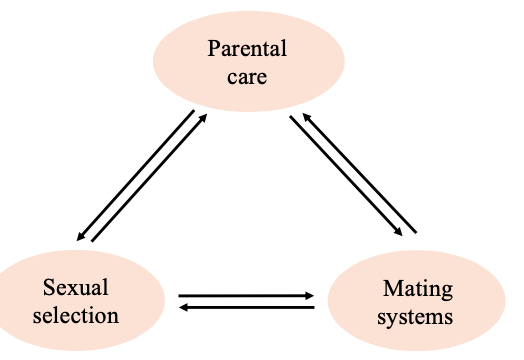 Charles Darwin (1871):
Charles Darwin (1871):
-> selection due to competition over mating access
Two mechanisms
intrasexual selection
-> competition within one sex for members of opposite sexusually male-male competition (species with conventional sex roles)
intersexual selection
-> differential choice by one sex among members of opposite sex
-> usually female choice (conventional sex roles)
Evolutionary outcome:
Selection for male sexual ornaments & armaments (Colours, horns, weaponry)
Description of mating systems:
Definition- Includes number of mating partners per male & female, & nature & duration of pair bond
Different mating systems:
monogamy (1:1)
polygyny(male mates loads, female only mates male)
polyandry (female has many mates, male has one)
polygynandry (all multi mate)
promiscuity (multi partner no selection base etc)
relationship between mating systems & sexual selection
Strong selection - male sexual ornaments associated with polygyny
Robert Trivers:
First to link parental care & sexual selection
Trivers: probably most influential & original thinker in the study of parental care.
He made important contributions to links between parental care & sexual selection, parent-offspring conflict & sex allocation
Introduced term ‘parental investment’ & proposed the concept of parent-offspring conflict.
Quote→ ‘where one sex invests considerably more than the other, members of the latter will compete among themselves to mate with members of the former’
this argument is likely to be wrong though.
Trivers (1972): argument - Drosophila melanogaster
-> influenced by Bateman (1948)
-> allow flies to mate with different number of partners
-> genetic markers: assign offspring’s parentage
Bateman allowed flies to mate with different number of partners Used genetic markers to assign offspring’s parentage
Differential effect of number of mates on reproductive success:
What Bateman found:
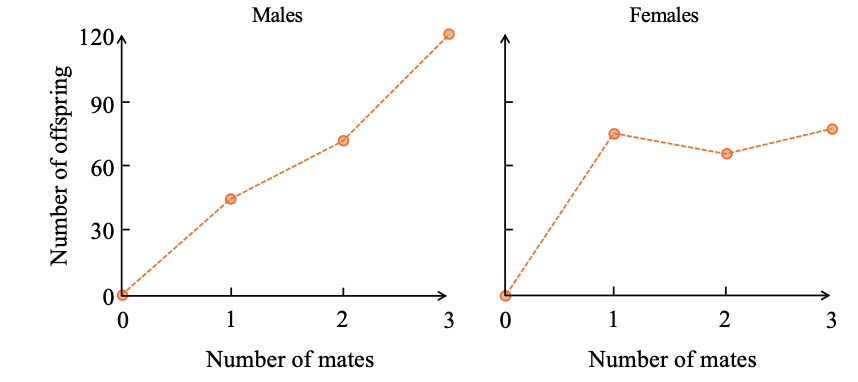
Number of mates had a differential effect on reproductive success (RS) in males & females
Males: RS increases linearly with number of mates
Females: RS does not increase after 1st mate
Variation in reproductive success:
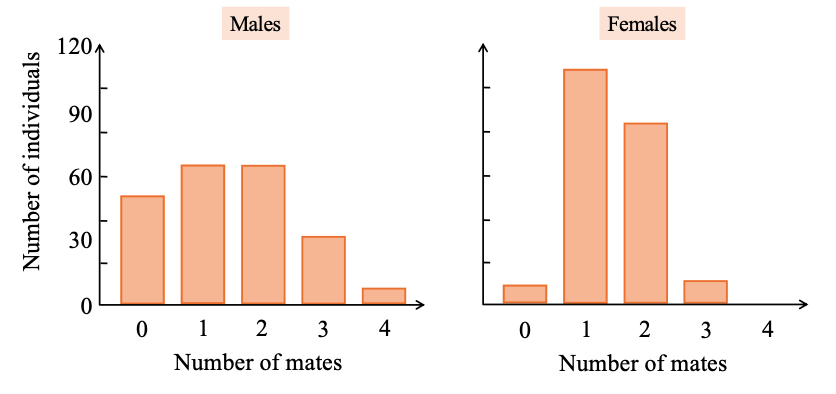
More variation in number of mates among males than among females
Many males fail to mate, few females do so
Most successful males have more mates than most successful females More variation in RS among males
Bateman (1948):
Sex differences linked to differential investment in gametes Aniosogamy: eggs are much larger than sperm
Consequence of anisogamy:
1. Male reproduction is limited by access to receptive females
2. Female reproduction is limited by ability to produce eggs; that is, limited by access to resources
Parental investment hypothesis -
Trivers (1972) argument:
Production of gametes is form of premating parental investment
Anisogamy: investment in eggs by females is greater investment in sperm by males
1. Initial asymmetry in gamete investment causes female-biased parental investment after hatching
Females have more to loose from breeding failure due to their higher initial investment => selection to continue their investment
2. Female-biased parental investment after hatching causes selection for male sexual ornaments & armaments Females become limited resource tp males => males under selection to compete for access to females
Question: do you agree with argument?
Important & influential argument – largely unchallenged for >30 years!
Female bias investment leads to strong sexual selection mates.
Recent criticism of Trivers’ argument: summarised in Kokko & Jennions (2008)
Two problems:
Problem 1: initial asymmetry in gamete investment causes female-biased parental investment after mating
Trivers’ argument: females have more to loose from breeding failure, so should continue to invest after mating
What is the problem with this argument? -> they would loose just as much putting energy into an egg which will not survive.
Parents should base investment on the expected returns you can get from that continued investment. Will it pay off?
Problem 1: termed the ‘Concorde fallacy’ (Dawkins & Carlisle 1976)
British and French governments continued to spend money on Concorde despite huge losses – did so to justify past investments
Translated to parental care: means that parents make decision about current investment based on past investment. What is the alternative?
The alternative is that parents should make decisions about current investment based on expected future returns from continued investment
If continued investment is not beneficial – parents should not provide more care This is the best strategy that should be favoured by selection
Problem 2 of Trivers’ argument:
Trivers argued that female-biased investment after mating will cause strong selection for male sexual ornaments & armaments
Trivers’ argument: female-biased investment after mating leads to a male-biased operational sex ratio (OSR)
This means that the number of sexually active males is greater than the number of receptive females – this is because when females are caring for young they are removed from the breeding pool. So more males than female
This causes very intense male-male competition & therefore selection for traits that increase male mating success
This in turn leads to selection against male investment after mating because it decreases ability to mate with other females
Question: Do you agree with this argument? - > no alternative explained.
→ Problem with this argument is that it is unclear that intense male-male competition should select for traits that increase male mating success & select against male
investment after mating
→ Keep in mind that it would be easier for females to find a new mate & that most males would be unsuccessful What is the alternative?
The alternative is that intense male-male competition will select for female desertion & male investment - the opposite to what Trivers’ argued!
Keep in mind example on penduline tits: male more likely to care at end of season - less likely to find a mate
Sexual selection hypothesis-
Kokko & Jennions (2008)
-> mathematical model
-> predict outcome of complex interactions among many factors
ASSUMES:
Caring parents -
→ stay with offspring for time period Tf (females) & Tm (males) -> then return to mating pool (time out/time in model)
Mating rate-
How quickly they can find a mate – depends on OSR (operational sex ratio): the ratio of sexually active males to receptive females in population
-> depends on OSR
-> ratio of sexually active males to receptive females in population
Sexual selection
-> unequal mating success among males
Sperm competition
-> reduced parentage to males
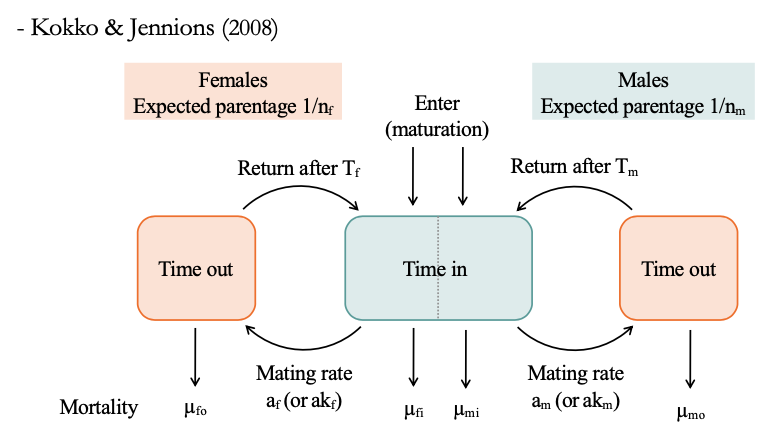 - Schematic illustration of model: ‘time in’ and ‘time out’ approach Time in = time spent in mating pool
- Schematic illustration of model: ‘time in’ and ‘time out’ approach Time in = time spent in mating pool
- Time out = time spent caring: cost of care - not part of mating pool Mortality is shown as they can die when caring for young.
Details of model not important
SCENARIO 1:
no sexual selection & no sperm competition
-> anisogamy: only asymmetry between sexes
-> no effect of anisogamy will lead to egalitarian sex roles
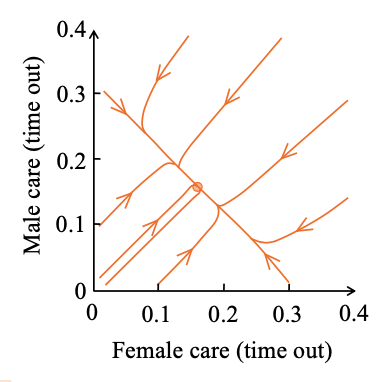
Predicted outcome: egalitarian sex roles – males & females provide same level of care
This model: anisogamy is the only asymmetry between the two sexes – anisogamy has no effect on sex roles (same amount of time outwith mating pool)
Stable point is 0.3
Unbiased OSR
Arrows show evolutionary trajectories – all move towards same point regardless of starting point
1st scenario: OSR prevents sex role divergence
Example: if OSR is male-biased (male time out < female time out) - males will have lower male mating success => this leads to increased male care
Male-biased OSR also leads to higher female mating success because it is easy to find a new mate => this leads to reduced female care
Stable outcome: female care = male care & unbiased OSR
SCENARIO 2:
moderate sexual selection or sperm competition -> partial sex role divergence
-> female care > male care
-> no effect of anisogamy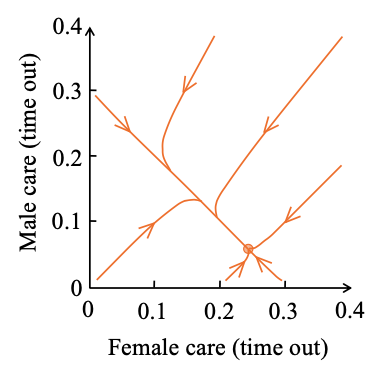
Prediction: partial sex role divergence => females provide more care than males, but males still provide some care
Again: no effect of anisogamy
Divergence due to sexual selection & sperm competition
SCENARIO 3:
strong sexual selection or sperm competition
-> full sex role divergence
-> no male care
-> no effect of anisogamy
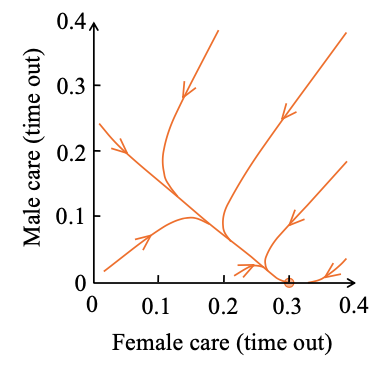
Prediction: full sex role divergence - females provide all care, but males provide no care — No effect of anisogamy
- Divergence due to sexual selection & sperm competition
full sex role divergence
WHY? ->
sperm competition
-> reduced parentage to males
-> lower benefits of care
-> reduced or no male care
-> Lecture 14: sperm competition & male care
Effect of sperm competition: reduced parentage to males and lower benefits of male care Leads to reduced or no male care.
Effect of sexual selection: unequal mating success among males (why sexual selection matters)
1. Attractive males: high chance of remating so will seek matings with other females This leads to reduced or no care among these males
2. Non-attractive males: low or no mating success
They will therefore have few or no own offspring => these males have little or no benefits from care
So attractive males have a high chance of re mating. Even though they have sired offspring, they have a very high chance of repeating that with another female because they're attractive.
So for the attractive males, it pays to abandon and seek matings with other females because they have a highchance of of getting those matings.
So that's the reason they don't provide any care or provide very little care.
Non attractive males provide no care for a different reason. And that's because they are unlikely to have sired any offspring. And if they haven't, they obviously don't have any offspring that they can care for. So that's why we expect them not to provide any care.
Two alternative hypotheses:
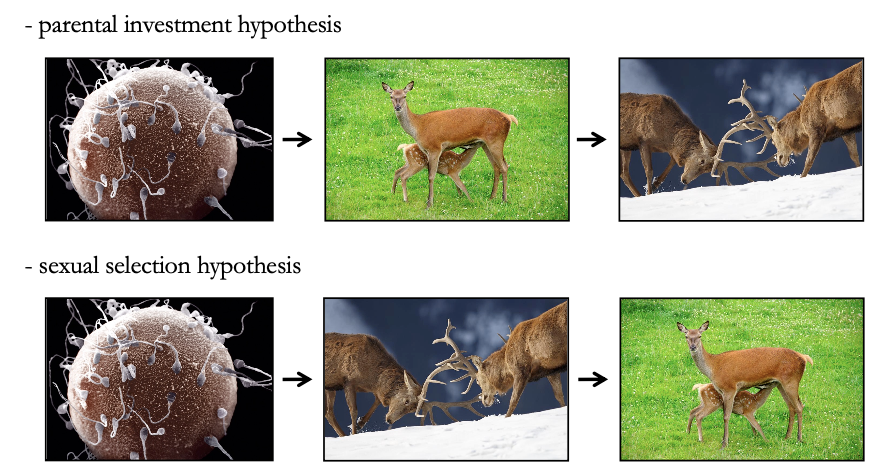
Parental investment hypothesis: anisogamy leads to female-biased investment, which leads to strong sexual selection on males (Trivers 1972)
Sexual selection hypothesis: anisogamy allows for strong sexual selection on male(sperm comp.), which leads to female-biased investment (Kokko & Jennions 2008)
Tanganyikan cichlids - CASE STUDY
Lake Tanganyika:
-> large lake East Africa -> world’s oldest lake -> 20 million years
Cichlids
-> almost 200 endemic species
Diverse forms of parental care
(variation between which sex cares for young)
uniparental female care
biparental care
diverse intensity of sexual selection/ mating systems
sexual dimorphism and polygyny or have sexual monomorphic and monogamous species.
mating systems
We do this by building a phylogeny =>
Question: how is phylogeny constructed? Answer: molecular/genetic data Reconstruct likely ancestral states based on information on current ones
Look at evolutionary transitions: biparental care => uniparental female care & moderate sexual selection => strong sexual selection
So the way we do this, we build the phylogeny use genetic data to to build the engineer.
And then we so have it to closely related species and then more distantly related to this. And then they are this is where they fit in within the phylogenetic tree for this particular group and for each species, we describe them in terms of their current traits for sexual selection and for parental care.
Either have strong sexual selection or moderate. They are then classed by parental care so unit parental female care or juts parental care.
And then we can try to work out the evolutionary transition. So in the same as we did for the shorebird paper, we can now try to work out using parsimony. – How many times do we expect a transition from either moderate sexual selection to to strong sexual selection or from bi parental care to female care?
We are trying to be counting up how often these transitions are happening. And we can then test between these because the two are processes differing which trait is leading and which trait is following.
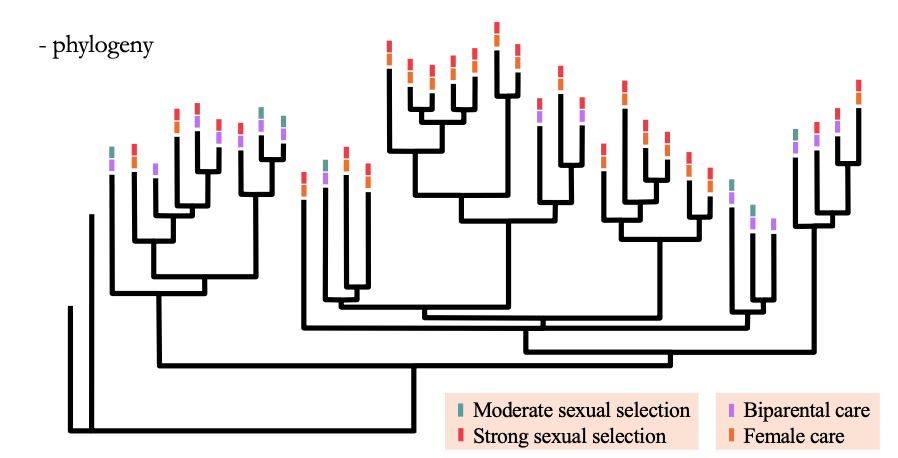
Parental investment hypothesis → Tanganyikan cichlids
Prediction: changes in parental care should happen first, then followed by changes in sexual selection Change from biparental care & moderate sexual selection towards female care & intense sexual selection: first change from biparental care to female care
This is then followed by change from moderate sexual selection to intense sexual selection

Sexual selection hypothesis → Tanganyikan cichlids
Prediction: changes in sexual selection should happen first, then followed by changes in parental care
Change from biparental care & moderate sexual selection towards female care & intense sexual selection: first change from moderate sexual selection to intense sexual selection
This is then followed by change from biparental care to female care
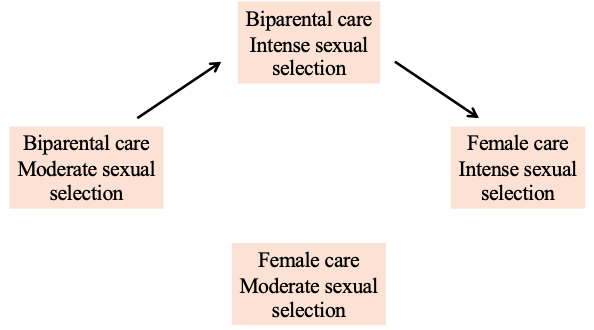 Results: strong support for sexual selection hypothesis
Results: strong support for sexual selection hypothesis
Changes in sexual selection followed by changes in parental care: support for sexual selection hypothesis
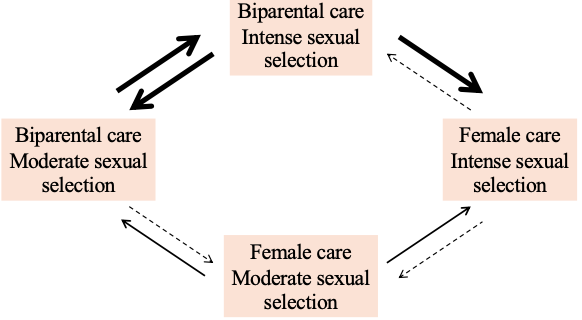
Summary→
Sex roles: close relationship between parental care, sexual selection & mating systems
Trivers’ (1972): verbal argument => sex differences in parental care drive sexual selection
Kokko & Jennions (2008): mathematical model => sexual selection & sperm competition drive sex differences in parental care
Empirical evidence: support for Kokko & Jennions (2008)
Complex issues: verbal arguments often of limited value -> important role for mathematical modelling, hard to spot flaw by just discussion need more evidence like math model to back it up.